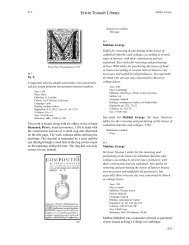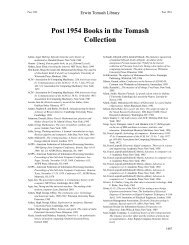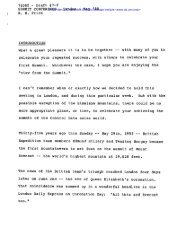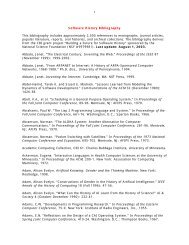B chapter.indd - Charles Babbage Institute - University of Minnesota
B chapter.indd - Charles Babbage Institute - University of Minnesota
B chapter.indd - Charles Babbage Institute - University of Minnesota
Create successful ePaper yourself
Turn your PDF publications into a flip-book with our unique Google optimized e-Paper software.
Erwin Tomash Library<br />
Bradbury, Fred Brahe, Tycho<br />
Binding: original paper wrappers<br />
Pagination: pp. 342–348<br />
Size: 225x142 mm<br />
In this paper, Boys proposes and describes a new type<br />
<strong>of</strong> integrating mechanism in contrast with existing<br />
integrating machines such as Amsler’s planimeter,<br />
where rolling mechanisms were employed to form the<br />
integral <strong>of</strong> the area being traced by a pointer. At the time<br />
this paper was written, Boys had built only a feasibility<br />
model. A few years later, Bruno Abdank-Abakanowicz<br />
described in great detail a complete design using the<br />
same principle. The Abakanowicz book acknowledges<br />
the fact that Boys had presented this same approach at<br />
the meetings <strong>of</strong> the British Association in 1882.<br />
Illustrations available:<br />
Plate showing instrument.<br />
B 222<br />
Bradbury, Fred<br />
Jacquard mechanism and harness mounting<br />
Year: 1912<br />
Place: (Halifax)<br />
Publisher: Author<br />
Edition: 1st<br />
Language: English<br />
Figures: 1 photolith plate<br />
Binding: original cloth boards<br />
Pagination: pp. 355, xii, [1]<br />
Collation: A–Y 8 (+W 8 )<br />
Size: 210x135 mm<br />
Bradbury was known for his books on various industrial<br />
subjects. He had already produced similar works<br />
on Carpet manufacture and Calculations in Yarns<br />
and Fabrics, and this book has advertisements and<br />
testimonials for both.<br />
After an introduction to the history <strong>of</strong> pattern weaving,<br />
this work deals with the Jacquard loom in all its forms,<br />
including a discussion <strong>of</strong> the creation <strong>of</strong> Jacquard cards.<br />
The book is well illustrated with technical drawings <strong>of</strong><br />
the various devices.<br />
Illustrations available:<br />
Title page<br />
B 223<br />
Brahe, Tycho (1546–1601)<br />
Astronomiæ instauratæ mechanica<br />
Year: 1602<br />
Place: Nürnberg<br />
Publisher: Levinus Hulsius<br />
Edition: 2nd<br />
Language: Latin<br />
B 222<br />
Figures: engraved portrait <strong>of</strong> Brahe on title, 25 illustrations (7<br />
engraved, 18 woodcut), 4 smaller illustrations in text<br />
Binding: contemporary vellum<br />
Pagination: ff. [54]<br />
Collation: )::( 4 A–E 6 F 4 G–H 6 I 4<br />
Size: 314x207 mm<br />
Reference: Gin HLB, Vol. XIX, #2, p. 129; Cro CL, #104<br />
Tycho Brahe, one the greatest and most celebrated<br />
astronomers in history, was born in Knudstrup, Denmark<br />
(present-day Sweden), into a noble family. His Danish<br />
given name was Tyge, and he adopted the Latinized<br />
version (Tycho) when he was fifteen years old. From the<br />
age <strong>of</strong> two, Tycho lived with and was reared by his paternal<br />
uncle, Jörgen Brahe. Jörgen saw to it that he was tutored<br />
in Latin and Greek and otherwise prepared for university<br />
studies. As befitted a person <strong>of</strong> his rank and position, he<br />
studied law at the <strong>University</strong> <strong>of</strong> Copenhagen and later<br />
at the <strong>University</strong> <strong>of</strong> Leipzig. His interest in astronomy<br />
was aroused by attending lectures on the subject, but his<br />
uncle strongly discouraged further studies, and he was<br />
reduced to learning the subject in secret.<br />
The conjunction <strong>of</strong> Saturn and Jupiter in August 1563<br />
seems to have been a seminal event for Tycho. He followed<br />
it meticulously and recorded his observation <strong>of</strong> the time<br />
<strong>of</strong> closest approach. When he computed this same time<br />
using both the Alphonsine tables and the Prutenic tables,<br />
the discrepancy between the observed and calculated<br />
results was striking. In fact, the Alphonsine tables were<br />
<strong>of</strong>f by nearly a month and the Prutenic tables by a few<br />
187







